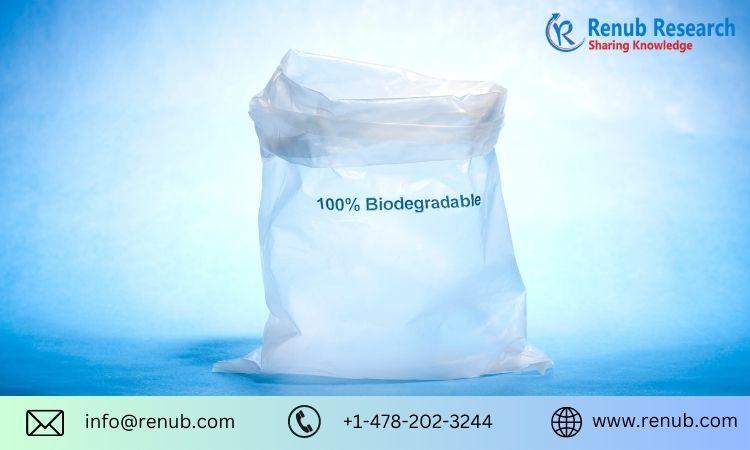Global Biodegradable Plastics Market is projected to experience a compound annual growth rate (CAGR) of 8.72% between 2021 and 2027. As consumers seek environmentally-friendly options, biodegradable plastics are emerging as a popular substitute for traditional materials. Unlike conventional plastics, which remain stable for hundreds of years and were initially valued for this property, biodegradable plastics can be decomposed by microorganisms, broken down into biomass, water, and carbon dioxide.
The global biodegradable plastic market is currently in its introductory phase, but it is anticipated to discover new growth prospects in the years ahead. The market’s demand is being driven by various factors, such as governmental initiatives to eliminate single-use plastic and a strict regulatory approach towards conventional plastic products. It is anticipated that the worldwide market for biodegradable plastics industry will achieve a value of USD 7.15 Billion by 2027.
In recent years, prominent plastic companies have shown a growing interest in offering a more environmentally-friendly alternative to businesses and consumers. This trend is evident in various sectors, including energy, agriculture, and fuels. However, bioplastics stand apart from these sectors as the industry does not depend on government subsidies. Instead, the onus is on manufacturers to develop cost-effective solutions and enhance their presence in the plastics market.
There is a trend towards biobased products as a means of reducing reliance on traditional plastics, and a growing number of manufacturers in industries such as packaging, textiles, and agriculture are switching to biobased plastic to comply with governmental regulations. These factors are significantly influencing the growth of the biodegradable plastic market. According to Renub Research, research report “Biodegradable Plastics Market Size, Global Forecast 2021-2027, Industry Trends, Impact of COVID-19, Opportunity Company Analysis” Biodegradable Plastics Market for 2021 was USD 4.1 Billion.
China is both the Biggest Producer and Consumer of Plastics Industry
China, the world’s largest producer and consumer of plastic, consumed millions of tons of plastic in 2022. While biodegradable plastic production is increasing rapidly in China, the country’s ability to degrade the materials is being outpaced. The growing demand for sustainable packaging materials is one of the main drivers of the biodegradable plastics market. The European market for sustainable products and packaging is expanding due to various factors such as the transition to a low-carbon and circular economy, stronger policy support for the bioeconomy, and increased consumer awareness for sustainable products. For example, the European Union recently banned single-use plastics, including straws, plates, and cutlery, which is expected to boost demand for biodegradable alternatives.
The food and beverage industry is also focusing on sustainability, and many companies are turning to biodegradable plastics to reduce their environmental impact. Biodegradable plastics can be used to create food packaging, cutlery, and utensils, providing a more sustainable alternative to traditional plastic products. Government regulations are another driving force in the biodegradable plastics market. Many countries are introducing regulations that require companies to reduce their use of traditional plastics, and biodegradable plastics are often seen as a viable alternative.
Based on Product: Starch will dominated the Industry
Based on product, the market is divided into starch-based, PLA, PBAT, PBS, PHA, and others. The starch-based segment is projected to dominate the market in terms of value as well as volume throughout the forecast horizon. Starch-based plastics are used in application industries such as packaging, automobiles, and agriculture. The PLA Product plastics are also rapidly gaining their ground in the arena. The inexpensive cost of PLA compared to any other Product is a major driving factor for the segment. PHA is projected to register significant growth during the forecast period.
Restraints in the Biodegradable Industry
Despite these drivers, the biodegradable plastics market faces some challenges. One of the biggest challenges is the cost of these materials, which can be higher than traditional plastics. This can make it difficult for companies to justify switching to biodegradable plastics, particularly in industries where profit margins are already tight.
The presence of numerous players across various regions has created a global competition in the market. Additionally, the demand for biodegradable plastics is expected to surge in developed as well as developing economies. As a result, significant market players are investing in research and development to incorporate strong and easily degradable biodegradable plastic products into their offerings. Leading companies in this industry include Total Corbion from the Netherlands, Mitsubishi Chemical Holding Corporation and Toray Industries from Japan, as well as Biome Bioplastics and GREEN DOT BIOPLASTICS from the UK.



